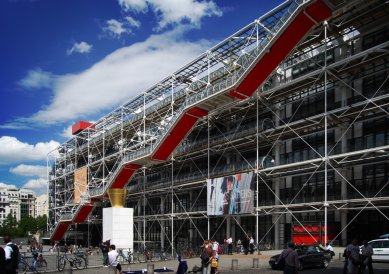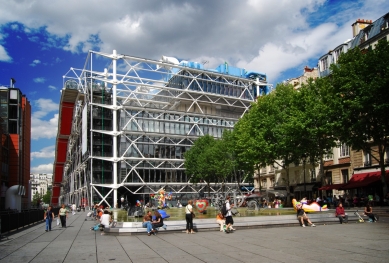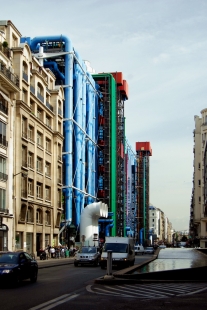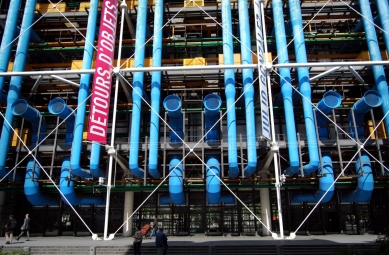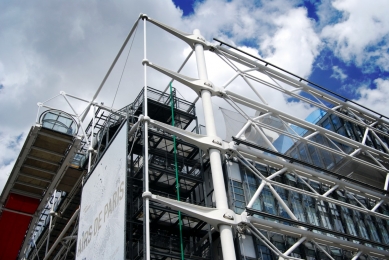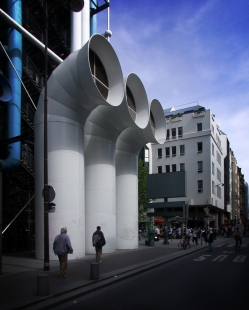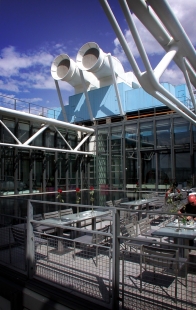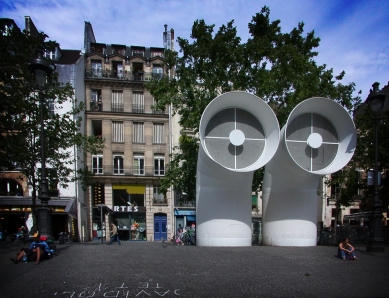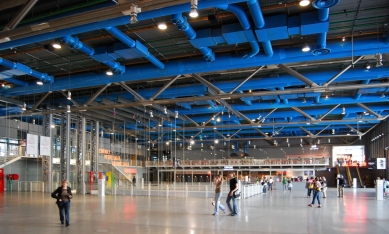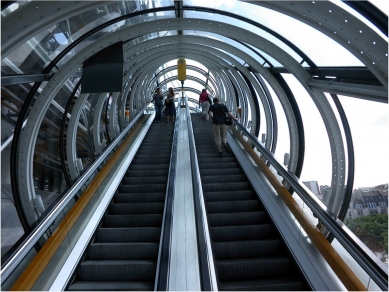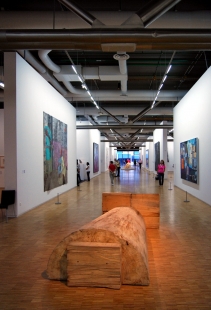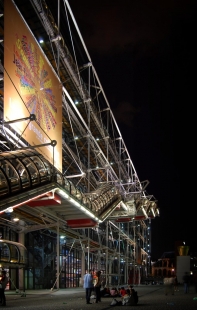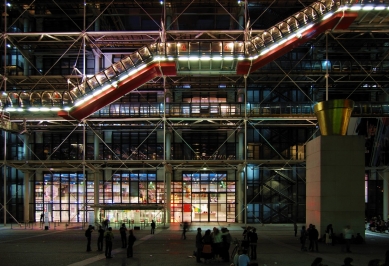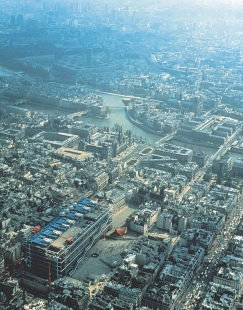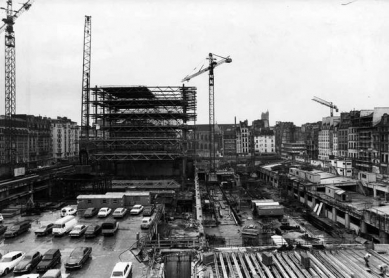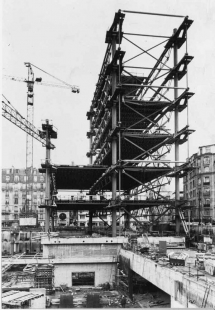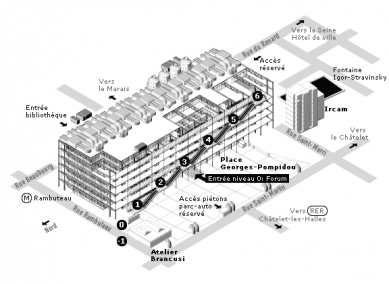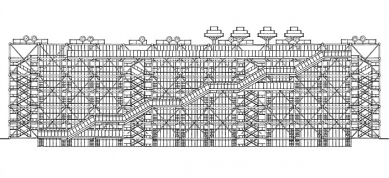
Centre Pompidou

Voice of the people, voice of God
The ultramodern Centre Georges Pompidou, looking like a "naked" chemical plant, is incredibly strange. The Temple of the Mother of God of Pipes.
Well, thank goodness I'm not a Parisian, because otherwise, I would probably belong to those conservatives who scold architects.
A refinery skinned of its skin.
It was probably built by some former plumber.
Gesamtkunstwerk of bureaucracy.
The Centre Pompidou looks as if the bricklayers forgot to take down the scaffolding. But then again, there's no disputing taste.
Supermarket of culture.
Well, the architect saw further into the future than the rest of us confused folks.
But it is fun there.
The ultramodern Centre Georges Pompidou, looking like a "naked" chemical plant, is incredibly strange. The Temple of the Mother of God of Pipes.
Well, thank goodness I'm not a Parisian, because otherwise, I would probably belong to those conservatives who scold architects.
A refinery skinned of its skin.
It was probably built by some former plumber.
Gesamtkunstwerk of bureaucracy.
The Centre Pompidou looks as if the bricklayers forgot to take down the scaffolding. But then again, there's no disputing taste.
Supermarket of culture.
Well, the architect saw further into the future than the rest of us confused folks.
But it is fun there.
Czech-Slovak visitors / non-architects.
Centre Pompidou - uninterrupted space for art wrapped in pipes
What should a sanctuary of modern art of the twentieth century look like? A challenging task assigned by French President Georges Pompidou was tackled by nearly seven hundred architects. Richard Rogers and Renzo Piano performed the best. The result, "a building with exposed guts", reminiscent to many of a refinery or simply a factory, opened its doors to supporters of modern art on the last day of January 1977. The National Center for Arts and Culture Georges Pompidou in Paris, more commonly known by the shorter name Centre Pompidou or by the side street Beaubourg, will celebrate its thirtieth anniversary on Wednesday.
Beaubourg resembles a factory more than a cultural center - brightly colored pipes and tubes run externally along the walls like "technical intestines" of the building. The structure appears turned inside out: escalators, elevators, plumbing, and air conditioning, as well as the entire building's construction - massive steel supports - can be found on the outer shell of the building. Inside, an uninterrupted space has been created. Behind the glass and metal, there lies not only a museum with a remarkable collection of 20th-century visual art but also a center for industrial design, a film museum, and concert halls.
In 1969, then-French President Georges Pompidou came up with the idea for the construction of an original cultural center where contemporary art collections could be housed, a public library would operate, films would be screened, music and theater would be performed, and literature would be read. The architects who ultimately won the international competition rejected all traditional arrangements and prioritized creating enough space - Renzo Piano, Richard Rogers, and Gianfranco Franchini. Construction began in 1972 and lasted five years.
One of the most popular Parisian landmarks has not had an easy life during its (not long for a building) existence. Many people initially perceived it as an ugly stain on the historical center of the French capital. Critics spoke of futuristic ugliness and mocked the colorful pipes on the facade. Nevertheless, the unusual building in the Marais district, with a magnificent view of Paris, has become an inseparable part of the Parisian scenery. Its popularity among visitors has exceeded expectations to such an extent that after just twenty years, Beaubourg had become so worn that it warranted an expensive 27-month renovation. Beaubourg was visited by four times the expected five thousand visitors daily. Today, their annual number reaches a respectable seven million.
Paradoxically, the project authors were posed the question by Georges Pompidou: "Do you realize that this building must last five hundred years?", to which the answer was: "Of course, Mr. President."
The renovation brought not only technical renewal but also a new layout for the entire center. The total area of all floors now exceeds 100,000 square meters. The most famous are the fourth and fifth floors hosting the National Museum of Modern Art, which has 14,000 square meters and showcases around 1,400 (of a total of 59,000) artworks, whereas before the renovation, it was around 800. The Beaubourg features cinemas, children's galleries, a popular library, a café, a restaurant, and spaces for temporary exhibitions. Children can also have fun with colors, fabrics, and other materials, creating a so-called children's gallery. Street artists, organ grinders, and musicians are also an inseparable part of the Centre Pompidou.
As the very first cultural institution in the world, the Centre Pompidou can proudly boast an ISO 9000:2000 quality certificate for its management and artistic management.
For Richard Rogers, now Lord Rogers of Riverside, one of the fathers of hi-tech architecture, the Centre Pompidou marked a successful milestone in his further career. He has cultural and industrial projects to his credit in France, the USA, and his native England - including the Lloyd's skyscraper and the massive London stadium Millennium Dome. His newly designed terminal at Madrid airport was named the best British building of the year last year.
Beaubourg resembles a factory more than a cultural center - brightly colored pipes and tubes run externally along the walls like "technical intestines" of the building. The structure appears turned inside out: escalators, elevators, plumbing, and air conditioning, as well as the entire building's construction - massive steel supports - can be found on the outer shell of the building. Inside, an uninterrupted space has been created. Behind the glass and metal, there lies not only a museum with a remarkable collection of 20th-century visual art but also a center for industrial design, a film museum, and concert halls.
In 1969, then-French President Georges Pompidou came up with the idea for the construction of an original cultural center where contemporary art collections could be housed, a public library would operate, films would be screened, music and theater would be performed, and literature would be read. The architects who ultimately won the international competition rejected all traditional arrangements and prioritized creating enough space - Renzo Piano, Richard Rogers, and Gianfranco Franchini. Construction began in 1972 and lasted five years.
One of the most popular Parisian landmarks has not had an easy life during its (not long for a building) existence. Many people initially perceived it as an ugly stain on the historical center of the French capital. Critics spoke of futuristic ugliness and mocked the colorful pipes on the facade. Nevertheless, the unusual building in the Marais district, with a magnificent view of Paris, has become an inseparable part of the Parisian scenery. Its popularity among visitors has exceeded expectations to such an extent that after just twenty years, Beaubourg had become so worn that it warranted an expensive 27-month renovation. Beaubourg was visited by four times the expected five thousand visitors daily. Today, their annual number reaches a respectable seven million.
Paradoxically, the project authors were posed the question by Georges Pompidou: "Do you realize that this building must last five hundred years?", to which the answer was: "Of course, Mr. President."
The renovation brought not only technical renewal but also a new layout for the entire center. The total area of all floors now exceeds 100,000 square meters. The most famous are the fourth and fifth floors hosting the National Museum of Modern Art, which has 14,000 square meters and showcases around 1,400 (of a total of 59,000) artworks, whereas before the renovation, it was around 800. The Beaubourg features cinemas, children's galleries, a popular library, a café, a restaurant, and spaces for temporary exhibitions. Children can also have fun with colors, fabrics, and other materials, creating a so-called children's gallery. Street artists, organ grinders, and musicians are also an inseparable part of the Centre Pompidou.
As the very first cultural institution in the world, the Centre Pompidou can proudly boast an ISO 9000:2000 quality certificate for its management and artistic management.
For Richard Rogers, now Lord Rogers of Riverside, one of the fathers of hi-tech architecture, the Centre Pompidou marked a successful milestone in his further career. He has cultural and industrial projects to his credit in France, the USA, and his native England - including the Lloyd's skyscraper and the massive London stadium Millennium Dome. His newly designed terminal at Madrid airport was named the best British building of the year last year.
Kateřina Skůpová / ČTK, 29.01.2007
The English translation is powered by AI tool. Switch to Czech to view the original text source.
0 comments
add comment



